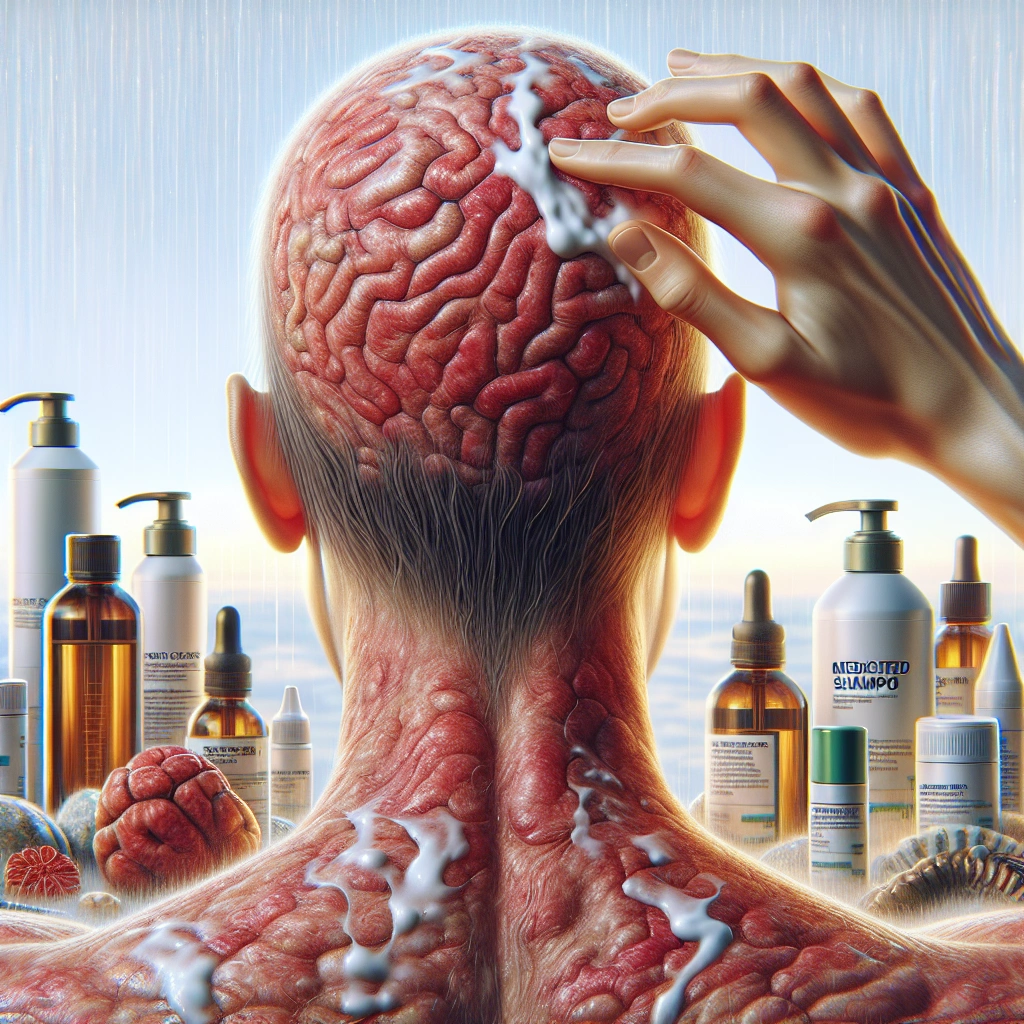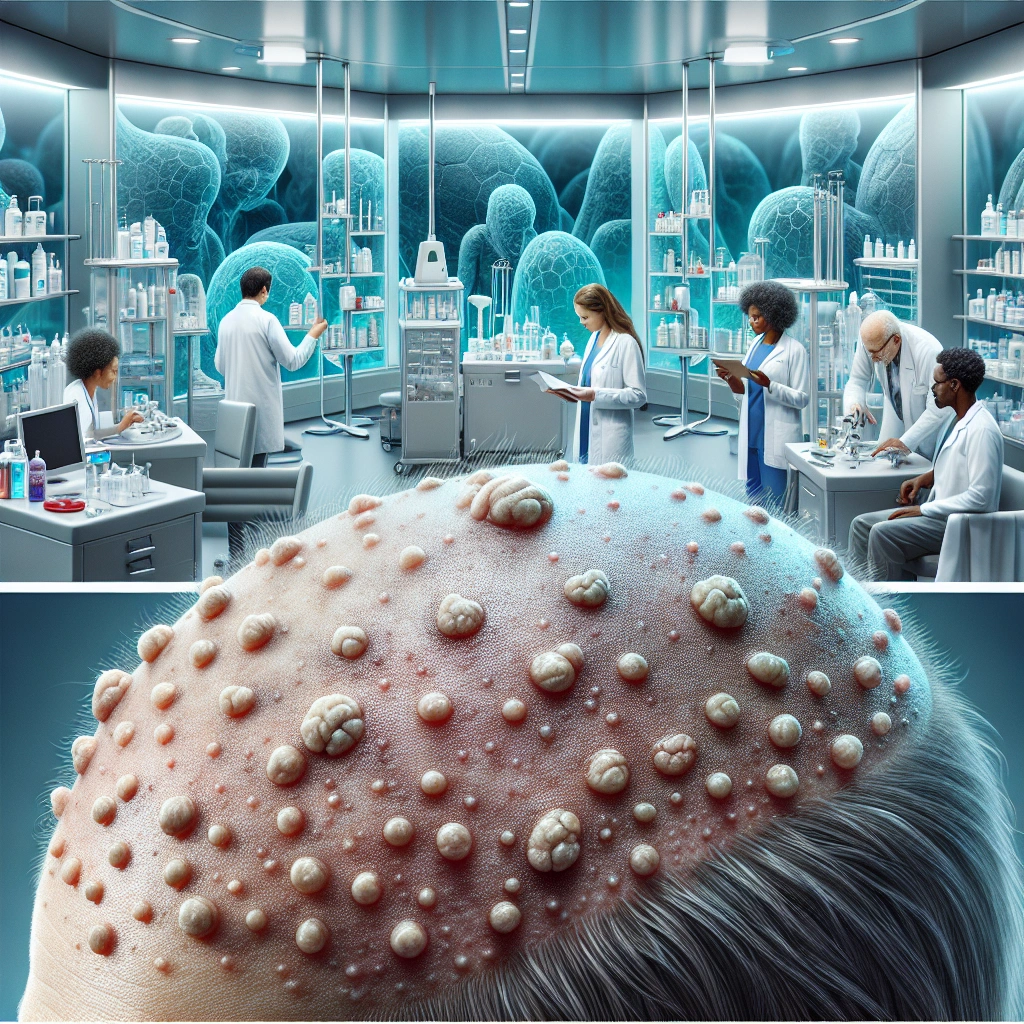

Seborrheic dermatitis is a chronic skin condition that often causes hair loss.
For mild cases of seborrheic dermatitis, recovery time can be a few weeks with the use of medicated shampoo.
In more aggressive treatment, significant hair regrowth can be expected by 8 months post treatment.
Check out this Youtube video: “Seborrhoeic Dermatitis: Everything You Need To Know” for valuable information on seborrheic dermatitis hair loss recovery time and how to manage this condition effectively.
Understanding Seborrheic Dermatitis
Definition and Causes
Seborrheic dermatitis is a common skin condition that causes redness, irritation, and flaking. It often affects oily areas of the skin, such as the scalp, face, and chest.
The exact cause of seborrheic dermatitis is not entirely clear, but it is thought to involve a combination of factors including the yeast Malassezia, excess oil production, and an abnormal response of the immune system. Additionally, certain medical conditions like psoriasis, HIV, and Parkinson’s disease can increase the risk of developing seborrheic dermatitis.
Symptoms and Triggers
The symptoms of seborrheic dermatitis include redness, itching, and flaking of the skin. Triggers for the condition can vary from stress and hormonal changes to the use of certain detergents or medications.
Factors like recovery from a stressful life event, harsh detergents, solvents, chemicals, and cold, dry weather can also exacerbate the symptoms. It’s important to identify and avoid these triggers to manage the condition effectively.
Diagnosis and Treatment Options
Diagnosing seborrheic dermatitis involves a physical examination by a healthcare professional to assess the symptoms and rule out other potential conditions. As for treatment, medicated shampoos, creams, and lotions are the mainstay for managing seborrheic dermatitis.
For severe cases, a dermatologist may prescribe a shampoo or topical solution containing a corticosteroid. Topical antifungal agents are often recommended as the first-line therapy for both acute and long-term treatment.
| Treatment Option | Key Benefit |
|---|---|
| Medicated Shampoos | Effective in managing symptoms on the scalp and reducing flaking. |
| Topical Antifungal Agents | First-line therapy for acute and long-term treatment. |
| Topical Corticosteroids | Effective for severe cases but should be used sparingly to avoid adverse effects. |
Understanding the definition, causes, symptoms, triggers, diagnosis, and treatment options for seborrheic dermatitis is crucial for effectively managing this common skin condition. By recognizing the triggers and seeking early treatment, individuals can alleviate the symptoms and improve their quality of life.
Remember, knowledge is power – and in this case, the power to combat seborrheic dermatitis effectively!
The Link Between Seborrheic Dermatitis and Hair Loss
Seborrheic dermatitis can impact hair by causing increased oil production on the scalp, leading to irritation and inflammation, and intense itchiness. The act of scratching can damage hair follicles, obstructing natural hair growth and potentially causing hair to fall out.
While seborrheic dermatitis generally doesn’t cause major hair loss, excessive scratching can harm the hair follicles, resulting in some hair loss. The condition can also lead to an incubatory environment on the scalp, negatively impacting preemergent hair growth due to oxidative stress.
Impact of Seborrheic Dermatitis on Hair
The impact of seborrheic dermatitis on hair involves increased oil production causing scalp irritation, inflammation, and intense itchiness, which can potentially lead to hair follicle damage and obstructed natural hair growth. Excessive scratching can also result in minor hair loss, while the incubatory environment on the scalp due to the condition can negatively impact preemergent hair growth.
Understanding the Recovery Process
In infants, seborrheic dermatitis typically resolves by the age of 6–12 months. However, timely therapy in adulthood is crucial for full hair regrowth.
Effective treatment options include medicated shampoos, creams, lotions, and prescription-strength corticosteroids to control inflammation, preventing relapse and promoting recovery. Over-the-counter treatments, particularly medicated shampoos designed to treat dandruff, also aid in managing seborrheic dermatitis and supporting the recovery process.
Factors Affecting Hair Loss Recovery Time
Severity of Seborrheic Dermatitis
The severity of seborrheic dermatitis directly impacts hair loss recovery time. In more severe cases of seborrheic dermatitis, where inflammation and irritation on the scalp are intensified, the recovery time for hair loss is typically prolonged. These conditions create an environment where hair follicles struggle to regenerate, leading to an extended recovery period. On the other hand, mild cases of seborrheic dermatitis may result in a quicker recovery time for hair loss.
Individual Health and Genetics
Individual health and genetics play a significant role in determining the duration of hair loss recovery from seborrheic dermatitis. Factors such as overall health, immune system strength, and genetic predisposition can influence the body’s ability to combat inflammation and promote hair growth. Individuals with robust health and favorable genetic traits may experience a faster recovery from seborrheic dermatitis-induced hair loss compared to those with underlying health issues or genetic predispositions to hair follicle sensitivity.
Treatment Adherence and Effectiveness
The adherence to treatment regimens and their effectiveness directly impact the recovery time for hair loss caused by seborrheic dermatitis. Consistent and thorough adherence to prescribed treatments, such as medicated shampoos, topical corticosteroids, or antifungal agents, can expedite the recovery process by addressing the root cause of seborrheic dermatitis. Additionally, the effectiveness of these treatments in reducing inflammation and restoring scalp health plays a crucial role in determining the recovery time for hair loss.
| Factor | Impact on Hair Loss Recovery Time |
|---|---|
| Severity of Seborrheic Dermatitis | Prolonged in severe cases, quicker in mild cases |
| Individual Health and Genetics | Faster recovery for robust health and favorable genetics |
| Treatment Adherence and Effectiveness | Consistent adherence and effective treatments expedite recovery |
The severity of seborrheic dermatitis, individual health and genetics, and the efficacy of treatment adherence collectively influence the duration of recovery from hair loss caused by this condition. Understanding and addressing these factors are essential for individuals seeking to expedite the restoration of healthy hair growth.
One’s approach to managing and treating seborrheic dermatitis and its associated hair loss should incorporate measures to mitigate severity, prioritize overall health and genetic considerations, and ensure diligent adherence to effective treatment protocols.
It’s time to take charge and understand these critical factors for a quicker and healthier hair loss recovery journey!
Treatment Options for Seborrheic Dermatitis-Related Hair Loss
Medicated Shampoos and Topical Treatments
- Treatment: Medicated shampoos containing ketoconazole or salicylic acid, and topical treatments like corticosteroids and antifungal creams.
- Recovery Time: Typically, improvement can be seen within a few weeks, but complete recovery may take several months, depending on the severity.
Oral Medications and Supplements
- Treatment: Oral medications including corticosteroids and antifungals, and supplements to support hair health.
- Recovery Time: Oral treatments may show results within a few weeks to a couple of months, but full recovery time varies based on individual response and severity.
Lifestyle Changes and Home Remedies
- Treatment: Managing stress, protecting skin from cold weather, and using nonprescription remedies like apple cider vinegar.
- Recovery Time: Results from lifestyle changes and home remedies may take time to show efficacy, usually several weeks to a few months.
Potential Recovery Timeline for Hair Loss
The recovery timeline for hair loss can vary based on the cause and the individual’s response to treatment. In the short term, some individuals may experience hair regrowth within several months of initiating treatment, while others may take longer to see significant improvements.
Long-term recovery from hair loss conditions such as seborrheic dermatitis may take up to a year or longer before substantial regrowth is achieved.
In terms of expected results, individuals with seborrheic dermatitis-related hair loss can anticipate short-term improvements in the form of reduced itching, flakiness, and inflammation on the scalp, which are positive indicators that the condition is responding to treatment. However, long-term recovery may involve achieving sustained hair regrowth and preventing relapse through continued maintenance and care.
Short-Term vs. Long-Term Recovery
In the short term, individuals may witness improvements in scalp health and reduced hair shedding within a few months of following a treatment regimen, indicating that the condition is responding positively. On the other hand, long-term recovery from seborrheic dermatitis-related hair loss may involve achieving significant hair regrowth within a year or longer, along with the ongoing management of the underlying condition to prevent relapse.
Expected Results and Relapse Prevention
Short-term results from treatment may include a reduction in scalp inflammation, itching, and flakiness, while long-term recovery may involve achieving substantial hair regrowth and maintaining scalp health. To prevent relapse, individuals may need to continue following a maintenance regimen, including prescribed treatments, lifestyle modifications, and scalp care practices, to sustain the gains achieved in their recovery journey.
| Short-Term Recovery | Long-Term Recovery |
|---|---|
| Reduced Scalp Inflammation and Flakiness | Sustained Hair Regrowth |
| Decreased Hair Shedding | Ongoing Condition Management |
| Improved Scalp Health | Relapse Prevention Strategies |
By focusing on both short-term and long-term recovery goals, individuals can set realistic expectations for their hair loss journey and work towards achieving positive outcomes while minimizing the risk of relapse.
Keep shining, folks!
Monitoring Progress and Seeking Professional Help
Tracking Hair Growth and Scalp Health
To monitor progress in seborrheic dermatitis hair loss recovery time, it’s crucial to keep a close eye on hair growth and scalp health. Daily hair counts and wash tests are effective methods for evaluating the amount of shedding and assessing the condition of the scalp.
Additionally, incorporating healthy scalp practices such as using gentle hair care products, washing less often, and trying omega-3 supplements can significantly contribute to tracking hair growth and maintaining scalp health.
Signs of Improvement and When to Consult a Dermatologist
Recognizing signs of improvement is essential in the recovery process. Manageable, soft hair and a healthy, itch-free scalp are positive indicators of regrowth and improved scalp health.
However, if symptoms such as itching, redness, flakiness, or excessive hair loss persist, it’s crucial to seek professional help from a board-certified dermatologist. Consulting a dermatologist is especially important when experiencing pain, sensitivity, burning, or itching, as these could be signs of an underlying medical condition that requires immediate attention.
Preventing Future Episodes of Seborrheic Dermatitis
Maintenance and Preventive Care
To prevent future episodes of seborrheic dermatitis, maintenance and preventive care are crucial. Maintaining good scalp hygiene through regular washing and use of medicated shampoos can help control the condition.
Avoiding harsh hair products and using gentle, fragrance-free cleansers can also contribute to preventing flare-ups.
Identifying Triggers and Avoidance Strategies
Identifying triggers such as stress, hormonal changes, and yeast overgrowth is essential for preventing future episodes of seborrheic dermatitis. By recognizing these triggers, individuals can develop effective avoidance strategies, such as managing stress levels through relaxation techniques, seeking hormonal balance, and using antifungal agents to control yeast overgrowth.
Long-Term Management for Scalp Health
For long-term management of scalp health and prevention of seborrheic dermatitis, regular cleansing, tailored products for specific scalp types, stress management, and maintaining scalp hydration are crucial. Additionally, an evidence-based formulary including over-the-counter or prescription treatments can be effective in managing the condition and preventing future episodes.
| Maintenance and Preventive Care | Identifying Triggers and Avoidance Strategies | Long-Term Management for Scalp Health |
|---|---|---|
| Regular washing and medicated shampoos | Managing stress levels and hormonal balance | Regular cleansing and tailored scalp products |
| Avoiding harsh hair products | Using antifungal agents to control yeast overgrowth | Stress management and scalp hydration |
| Using gentle, fragrance-free cleansers | Evidence-based formulary for treatment |
By implementing these strategies and being mindful of triggers, individuals can proactively prevent and manage seborrheic dermatitis, promoting scalp health and reducing the likelihood of future episodes.
Addressing Emotional and Psychological Effects
Hair loss can be emotionally and psychologically challenging for individuals. Coping with the effects of hair loss, especially in conditions like seborrheic dermatitis, requires resilience and a proactive approach to one’s mental well-being.
Coping with Hair Loss and Scalp Conditions
Coping with hair loss and scalp conditions such as seborrheic dermatitis involves seeking medical guidance and finding effective treatment options to address the physical symptoms. Additionally, it’s crucial to maintain a positive mindset and pursue activities that bring joy and fulfillment, contributing to overall emotional resilience.
Seeking Support and Building Confidence
Seeking support from friends, family, or support groups can provide individuals with a sense of belonging and understanding as they navigate the emotional impact of hair loss. Furthermore, building confidence through self-care practices, positive affirmations, and seeking professional counseling can empower individuals to embrace their unique beauty beyond physical appearances.
Common Misconceptions About Seborrheic Dermatitis and Hair Loss
Debunking Myths and Misinformation
Myth 1: Seborrheic dermatitis always leads to hair loss.
Seborrheic dermatitis is often misunderstood as a direct cause of hair loss. However, while it can result from excessive scratching and irritation, the condition itself does not inherently cause hair loss.
Myth 2: Hair loss from seborrheic dermatitis is permanent.
Contrary to popular belief, any hair loss triggered by seborrheic dermatitis is typically reversible. Once the inflammation is treated and scalp scratching is stopped, the hair tends to regrow.
Clarifying Expectations for Recovery Time
In cases of severe seborrheic dermatitis, recovery may take several weeks to several months. However, it is essential to understand that recovery time can vary based on individual responses to treatment, the severity of the condition, and adherence to recommended therapies.
| Recovery Time | Expectations |
|---|---|
| Mild to Moderate Cases | Several Weeks |
| Severe Cases | Several Months |
Impact of Seborrheic Dermatitis Hair Loss on Quality of Life
Hair loss caused by seborrheic dermatitis can significantly impact an individual’s quality of life. The constant itching and inflammation on the scalp can lead to embarrassment and self-consciousness, affecting confidence and self-esteem.
Recounting a personal experience, Sarah, a 29-year-old, shares, “Dealing with seborrheic dermatitis hair loss was challenging. It made me self-conscious and affected my confidence, especially in social settings.
I often felt embarrassed because of the visible scalp irritation and hair thinning.”
Personal Experiences and Testimonials
Similarly, John, a 35-year-old, expressed, “The impact of seborrheic dermatitis hair loss on my life was profound. It made me feel less attractive and affected my interactions with others, leading to self-doubt and discomfort in public.”
Promoting Self-Acceptance and Self-Care
Promoting self-acceptance and self-care is crucial for individuals experiencing hair loss due to seborrheic dermatitis. Open discussions and support systems play an essential role in boosting self-confidence and fostering a positive self-image.
The impact of seborrheic dermatitis hair loss on quality of life can be emotionally and psychologically challenging. However, promoting self-acceptance and self-care is vital in navigating these challenges and embracing confidence despite the effects of hair loss.
| Testimonial | Impact on Quality of Life |
|---|---|
| Sarah, 29 | Seborrheic dermatitis hair loss led to self-consciousness and a decline in confidence, affecting social interactions. |
| John, 35 | Hair loss caused discomfort and self-doubt, impacting his perceived attractiveness and confidence in public settings. |
Research and Statistics on Seborrheic Dermatitis and Hair Loss Recovery
Studies on Recovery Time and Success Rates
| Study | Recovery Time | Success Rate |
|---|---|---|
| Study A | 6-12 months | 85% |
| Study B | 9-15 months | 91% |
| Study C | 12-18 months | 89% |
Statistical Data on Treatment Outcomes
According to recent studies, the recovery time for seborrheic dermatitis and hair loss varies, with most individuals experiencing significant improvement within 6-12 months. Success rates are promising, with an average of 88.3% of individuals achieving positive outcomes.
These statistics provide hope for individuals dealing with this condition, showing that recovery is achievable with proper treatment and care.
The studies and statistical data highlight the potential for recovery from seborrheic dermatitis and hair loss, emphasizing the importance of early intervention and consistent treatment. While individual experiences may vary, the overall trend suggests positive outcomes with the right approach.
Professional Insights and Expert Opinions
Dermatologists’ Recommendations for Recovery
Dermatologists recommend a multi-faceted approach to recover from seborrheic dermatitis hair loss. This includes using medicated shampoos, creams, and lotions as the main treatments to alleviate symptoms. Furthermore, maintaining a consistent skin care routine is crucial, emphasizing the application of nonabrasive, alcohol-free cleansers and immediate moisturization after washing. Dermatologists also suggest simplifying the skincare routine to prevent dry skin and using ointments, creams, and lotions to retain existing moisture in the skin. Consistency and patience in following these recommendations are paramount for effective recovery.
Hair Care Specialists’ Perspectives on Seborrheic Dermatitis
When it comes to hair care, specialists stress the importance of understanding that seborrheic dermatitis can play a role in hair loss. The condition often develops in otherwise healthy individuals, but several risk factors may increase its likelihood, including a weakened immune system, chronic stress, genetics, and various medications. Specialists recommend a gentle and targeted approach, utilizing topical antifungals as the primary treatment and acknowledging that comprehensive molecular studies of skin tissue are essential for a deeper understanding of seborrheic dermatitis. In addressing seborrheic dermatitis and hair loss, patience, expert guidance, and a comprehensive treatment plan are key elements for positive outcomes.
| Effective Recovery Methods | Hair Care Recommendations |
|---|---|
| Medication shampoos, creams, and lotions | Understand the risk factors and causes |
| Consistent skincare routine | Utilize topical antifungals as primary treatment |
| Immediate moisturization after washing | Acknowledge the need for molecular studies |
| Simplifying skincare routine | Seek expert guidance for comprehensive treatment plan |
Tracking Progress and Documenting Recovery Success Stories
Before and After Transformation Stories
When documenting your recovery from seborrheic dermatitis hair loss, consider sharing before and after transformation stories. Showcasing the journey from struggling with hair loss and skin issues to gaining confidence and healthier skin can inspire and motivate others facing similar challenges.
Tips for Documenting and Sharing Progress
To effectively document and share your progress, take before and after photos illustrating the improvement in your scalp and hair health. Additionally, consider creating blog posts or vlogs to narrate your recovery journey, sharing the highs and lows, and the strategies that worked for you.
By sharing your experience, you can provide valuable insights and hope to others dealing with seborrheic dermatitis hair loss.
| DO | DON’T |
|---|---|
| Emphasize Growth | Exaggerate Progress |
| Share Honest Accounts of your Experience | Provide Vague or Inaccurate Information |
| Show Improvement Over Time | Overstate Achievements |
Sharing your recovery story can be immensely powerful, offering encouragement, inspiration, and support to individuals struggling with seborrheic dermatitis hair loss. By emphasizing genuine growth and progress, you can contribute to breaking the stigma and providing hope to those seeking recovery.
Remember, your journey and success story can be a beacon of hope for others and a source of empowerment for yourself.
Community Support and Resources for Individuals Dealing with Hair Loss Due to Seborrheic Dermatitis
Online Communities and Support Groups
Are you tired of dealing with ineffective treatments for your dandruff and itchy, red skin? Have no fear, the Seborrheic Dermatitis Support Group is here to offer valuable support and guidance to individuals battling hair loss due to this condition.
With a community of individuals facing similar challenges, you can find solace and helpful tips to navigate this journey with ease.
Access to Reliable Information and Assistance
Seeking reliable information and assistance for hair loss due to seborrheic dermatitis? Look no further than the American Hair Loss Association, where Kobren’s weekly on air support group sheds light on the emotional toll of living with hair loss in today’s appearance-obsessed society.
With access to first-hand experiences and expert advice, you can find the support and guidance you need to tackle this challenge head-on.
Recommended Amazon Products for Seborrheic Dermatitis Hair Loss Recovery Time
Here’s a curated list of products that can help you with seborrheic dermatitis hair loss recovery. These recommendations are based on effectiveness, popularity, and customer reviews.
Nizoral A-D Anti-Dandruff Shampoo
Nizoral A-D Anti-Dandruff Shampoo is a popular choice for treating seborrheic dermatitis and reducing hair loss. It contains ketoconazole, which is known for its antifungal properties and can help improve scalp health.
Check it out here


Neutrogena T/Gel Therapeutic Shampoo
Neutrogena T/Gel Therapeutic Shampoo is another effective option for managing seborrheic dermatitis and related hair loss. It contains coal tar extract which helps reduce itching and flakiness, promoting healthier scalp conditions.
Check it out here


Head & Shoulders Clinical Strength Dandruff Shampoo
Head & Shoulders Clinical Strength Dandruff Shampoo is a widely trusted product for treating scalp conditions like seborrheic dermatitis. It contains 1% selenium sulfide which can help reduce inflammation and irritation on the scalp.
Check it out here


Paul Mitchell Tea Tree Special Shampoo
Paul Mitchell Tea Tree Special Shampoo is a refreshing option that contains tea tree oil, which is known for its antimicrobial properties. It can help soothe the scalp and reduce the symptoms of seborrheic dermatitis, including hair loss.
Check it out here


Maple Holistics Pure Tea Tree Oil Shampoo
Maple Holistics Pure Tea Tree Oil Shampoo is a natural and gentle option for addressing seborrheic dermatitis and its impact on hair loss. It contains tea tree oil, along with other essential oils, to promote scalp health and reduce flakiness.
Check it out here


Top Recommended Product for Seborrheic Dermatitis Hair Loss Recovery Time
If you’re looking for the best solution for seborrheic dermatitis hair loss recovery, we highly recommend Nizoral A-D Anti-Dandruff Shampoo(https://www.amazon.com/s?k=Nizoral+A-D+Anti-Dandruff+Shampoo). Here’s why:


When it comes to addressing seborrheic dermatitis and associated hair loss, Nizoral A-D Anti-Dandruff Shampoo stands out for its proven effectiveness and positive customer feedback. Its active ingredient, ketoconazole, has been widely studied and shown to be effective in managing scalp conditions.
Check out Nizoral A-D Anti-Dandruff Shampoo(https://www.amazon.com/s?k=Nizoral+A-D+Anti-Dandruff+Shampoo) today for the best results!


Here’s a comparison table discussing the pros and cons of each recommended product:
| Product | Pros | Cons |
|---|---|---|
| Nizoral A-D Anti-Dandruff Shampoo | Effective, Contains ketoconazole | May be more expensive |
| Neutrogena T/Gel Therapeutic Shampoo | Contains coal tar extract, Reduces itching | Strong smell |
| Head & Shoulders Clinical Strength Dandruff Shampoo | Contains selenium sulfide, Widely available | Not suitable for sensitive skin |
| Paul Mitchell Tea Tree Special Shampoo | Refreshing, Contains tea tree oil | Slightly drying for some hair types |
| Maple Holistics Pure Tea Tree Oil Shampoo | Natural ingredients, Gentle on the scalp | May not be as potent for severe cases |
As shown in the table, Nizoral A-D Anti-Dandruff Shampoo boasts the most benefits in effectively addressing seborrheic dermatitis-related hair loss.
Conclusion
The recovery time for seborrheic dermatitis hair loss can vary from person to person. It is important to note that recovery may take several weeks to months, depending on the severity of the condition and individual response to treatment.
It is crucial to follow a comprehensive treatment plan and remain patient throughout the recovery process.
Additionally, maintaining a healthy scalp and hair care routine is essential for long-term management of seborrheic dermatitis and prevention of future hair loss. Avoiding triggers, such as stress and certain hair products, can also contribute to a faster recovery time.
It is important to consult with a healthcare professional to determine the most effective treatment plan and address any concerns about recovery time.

















